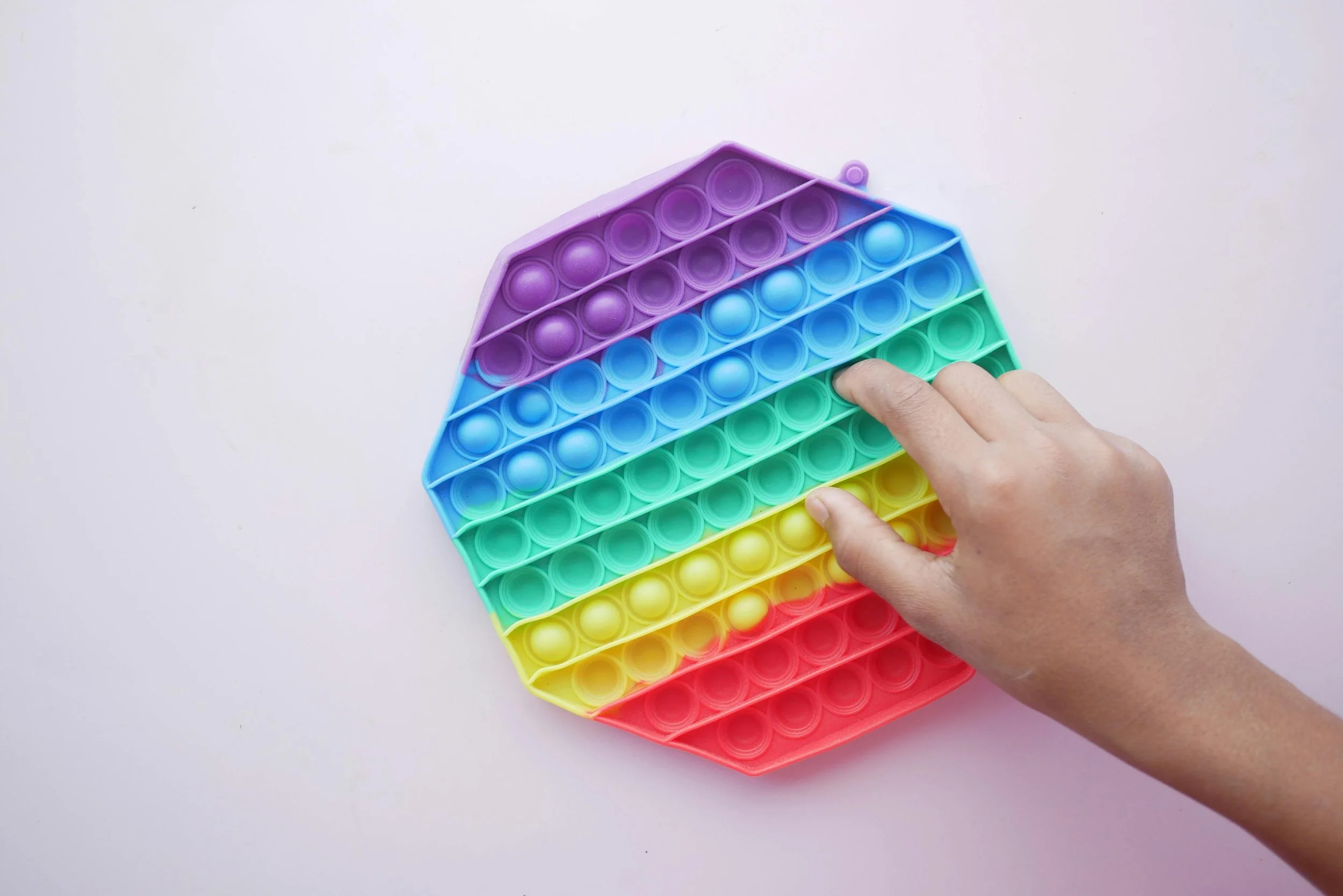Managing Repetitive Behaviors and Repetitive Language
Repetitive Behaviors and Repetitive Language
If you are the parent of an autistic child or if you are an autistic teen trying to understand your habits, you might be familiar with repetitive behaviors. These can include hand-flapping, repeating phrases over and over (called echolalia), rocking back and forth, lining up objects, or sticking to the same routine every day. Some people call these behaviors “stimming,” and while they might look unusual to others, they are actually quite common for autistic people, and they often serve an important purpose (Leekam et al., 2011).
Repetitive behaviors can help with calming down, focusing, or expressing emotions. They are not something that needs to be “fixed.” Trying to stop these behaviors without understanding why they happen can be harmful. However, sometimes, these behaviors might get in the way, like if they are dangerous, make school or home life difficult, or cause the person to feel overwhelmed or stuck. Learning how to manage those cases with compassion and support—not shame or punishment—can make life easier and more comfortable for everyone involved (Boyd et al., 2011).
Why Do Repetitive Behaviors Happen?
Repetitive behaviors often help autistic people feel safe and in control. When the world feels confusing or overwhelming—which can happen often if your brain processes things like noise, touch, or emotions differently—doing something repetitive can be soothing. For example, flapping your hands might help release extra energy or stress. Repeating words or phrases can help someone feel more certain about what they think or say (Leekam et al., 2011).
There are two types of repetitive behaviors:
Simple (lower-order) behaviors, like body movements (rocking, hand-flapping) or repeating sounds.
More complex (higher-order) behaviors, like needing to follow routines very closely, asking the same questions repeatedly, or having intense interests (Boyd et al., 2012).
Helpful Strategies for Managing Repetitive Behaviors
Both types are standard in autistic people and are not a sign of something wrong. The key is understanding when the behavior is helpful and when it might need support.
1. Understand the Purpose of the Behavior
Before trying to stop a behavior, ask: What is this behavior doing for my child (or for myself)? Is it helping to feel calm, focused, or express something? If so, it may not need to be changed at all. However, if it is making life harder—like interfering with school or relationships—it can help to find gentler ways to meet the exact need (Boyd et al., 2011).
2. Offer Alternatives, Not Punishments
Instead of telling someone to “stop stimming,” try offering a safer or quieter way to get the same feeling. This could be a fidget toy, a chewable necklace, or a calm space for movement. Sensory tools and quiet spaces can make a big difference, especially in busy or overwhelming environments (Raulston et al., 2019).
3. Use Routines and Visual Schedules
Many autistic children feel more comfortable with structure. Using picture schedules, timers, or step-by-step lists can help reduce the anxiety that often leads to repetitive behavior. Visual reminders make transitions easier and reduce the need for the child to repeat questions or actions (Raulston & Machalicek, 2017).
4. Practice Gentle Flexibility
Some repetitive behaviors come from needing sameness or routine. You do not need to remove routines altogether, but you can gently build flexibility. For example, if a child always wants the same cup, you might introduce a second favorite cup slowly. Celebrating small changes can help build tolerance for new things over time (Grahame et al., 2015).
5. Reinforce Helpful Behaviors
Positive reinforcement—like praise or small rewards—can encourage more flexible behavior. For example, if a child practices asking a question just once instead of many times, you might say, “I like how you asked that once and waited for an answer. That was great!” Over time, this kind of support can help reduce repetitive language that might be causing frustration or social difficulty (Boyd et al., 2011).
6. Include the Child in the Process
When possible, ask your child what helps them feel better. They might know what they need. If you are a teen reading this, you might want to make your own “calm kit” with sensory items or strategies that help you cope. Autistic people are experts in their own experience. Respect and collaboration go a long way.
What NOT to Do
Do not try to stop all repetitive behavior. Stimming is often helpful and harmless. It is part of how autistic people regulate their emotions and connect with the world (Leekam et al., 2011).
Do not punish or shame the behavior. This can cause more stress and even trauma. Instead, stay curious and supportive.
Do not over-rely on medication. Research shows that medications often do not work well for repetitive behaviors and can have side effects (Yu et al., 2020).
When to Get Support
If repetitive behaviors are very intense, dangerous, or interfere with daily life, it might be time to get help. Behavior therapists, occupational therapists, or autism specialists can work with your family to develop strategies. Evidence-based approaches like Positive Behavior Support (PBS) or Functional Communication Training (FCT) have been shown to help when used respectfully and collaboratively (Raulston et al., 2019).
Some new approaches, like brain stimulation therapies, are still being studied and are not yet widely used—but they may be helpful in the future (Lazzaro et al., 2025).
Conclusion
Repetitive behaviors are not “bad habits”—they are a meaningful part of many autistic people’s lives. Instead of focusing on stopping them, it is more helpful to understand them, support them when they are helpful, and gently guide them when they get in the way. With the right tools and mindset, parents and autistic kids can work together to build a calm, respectful, and supportive life.
References
Boyd, B. A., McDonough, S. G., & Bodfish, J. W. (2011). Evidence-based behavioral interventions for repetitive behaviors in autism. Journal of Autism and Developmental Disorders, 42(6), 1236–1248. https://doi.org/10.1007/s10803-011-1284-z
Grahame, V., Brett, D., Dixon, L., McConachie, H., Lowry, J., Rodgers, J., Steen, N., & Le Couteur, A. (2015). Managing repetitive behaviours in young children with autism spectrum disorder (asd): Pilot randomised controlled trial of a new parent group intervention. Journal of Autism and Developmental Disorders, 45(10), 3168–3182. https://doi.org/10.1007/s10803-015-2474-x
Lazzaro, G., Passarini, S., Battisti, A., Costanzo, F., Garone, G., Mercier, M., D’Aiello, B., De Rossi, P., Valeri, G., Guerrera, S., Casula, L., Menghini, D., Vicari, S., & Fucà, E. (2025). Understanding and targeting repetitive behaviors and restricted interests in autism spectrum disorder via high-definition transcranial direct current stimulation: A study-protocol. BMC Psychiatry, 25(1). https://doi.org/10.1186/s12888-025-06506-y
Leekam, S. R., Prior, M. R., & Uljarevic, M. (2011). Restricted and repetitive behaviors in autism spectrum disorders: A review of research in the last decade. Psychological Bulletin, 137(4), 562–593. https://doi.org/10.1037/a0023341
Raulston, T. J., Hansen, S. G., Machalicek, W., McIntyre, L., & Carnett, A. (2019). Interventions for repetitive behavior in young children with autism: A survey of behavioral practices. Journal of Autism and Developmental Disorders, 49(8), 3047–3059. https://doi.org/10.1007/s10803-019-04023-y
Raulston, T. J., & Machalicek, W. (2017). Early intervention for repetitive behavior in autism spectrum disorder: A conceptual model. Journal of Developmental and Physical Disabilities, 30(1), 89–109. https://doi.org/10.1007/s10882-017-9566-9
Yu, Y., Chaulagain, A., Pedersen, S., Lydersen, S., Leventhal, B. L., Szatmari, P., Aleksic, B., Ozaki, N., & Skokauskas, N. (2020). Pharmacotherapy of restricted/repetitive behavior in autism spectrum disorder:A systematic review and meta-analysis. BMC Psychiatry, 20(1). https://doi.org/10.1186/s12888-020-2477-9


